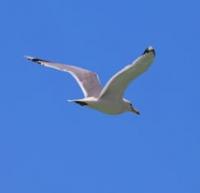You are here
Trip to Khazar Reserve.

Sights of Khazar Reserve.
"I made a pipe from a reed -
The usurer heard the debtor.
You are my birds! From a hawk
Can a tit hide?
"Swans". Translation by A. Tarkovsky. Makhtumkuli.
Best places in Khazar Reserve.
On the way to the seaside village of Gasan-Kuli, where the Yomud Turkmen live, we pass two large lakes - Big and Small Delili, overgrown with reeds. In autumn, the lakes are rather silent. But we know that the silence is deceptive, that from the green thickets near the shore you can frighten off the rare francolin, and in the thick of the aquatic vegetation many marsh inhabitants hide, and among them the beautiful Sultanka, or the Sultan's chicken - a bird with blue plumage, with a thick red beak and with rather long, also red legs, which she deftly uses to run on the floating leaves of aquatic plants.
This rare and cautious bird of the southern waters is nocturnal, and it is not so easy to see it, but its sharp unpleasant cry is heard at dusk.
It seems that nowhere, except for the lakes of Delili, this blue swamp bird and a small duck, with a short tail fanned over its back, are found together. Don't forget about this couple: we'll have to meet them again at the Hasan-Kuli carpet weavers.
The lakes and the coast are already the territory of the state Gasankuli reserve, in which waterfowl are protected. The reserve was created in 1932, when the Gasankuli Bay still existed and hundreds of thousands of black coots-Kashkadak, various ducks, geese, hundreds of red-breasted geese, swans and even pelicans and flamingos accumulated in it for wintering.
But the bay dried up, the wintering of birds in this area of coastal waters became scarce, and in 1968 the boundaries of the Gasan-Kuli reserve were expanded, and it itself was renamed Krasnovodsky. The Krasnovodsk Bay and areas of the sea adjacent to the Darja Peninsula, where the main wintering aggregations of valuable commercial and rare bird species have moved in recent years, have become protected areas.
The village of Gasan-Kuli is spread out on a completely flat, palm-like seaside lowland. There is almost no greenery in it, but its appearance is remembered. It does not look like any of the villages and regional towns of Turkmenistan.
Everything in it speaks of the proximity of the capricious sea: both the air, carrying the freshness and smells of sea water in the wind from the west, and the architecture of wooden houses placed on piles. After all, quite recently, when the Gasankuli Bay extended its arms to the village, with western winds, the sea waters rushed “to visit” without a call, and the inhabitants of the village were forced to use boats to move along the streets.
Piled buildings were then caused by necessity. Houses "on legs" are surrounded by verandas and balconies and seem light and beautiful. Pay attention to how during our journey only along Sumbar and Atrek the building material changed, and with it the architecture of human dwellings, in Kara-Kala, lying near the mountains, there is a stone supplemented with clay, and, accordingly, massive thick walls and high ceilings houses neatly built and whitewashed on the outside, in Kyzyl-Atrek, where there are no mountains in sight, there are low adobe buildings traditional in Central Asia.
And near the sea - a light wooden town of Gasan-Kuli, as if standing "on tiptoe" to look further into the sea, which bestows fish, birds and brings the joy of dangerous work to fishermen and excitement to those who remained on the shore.


Authority:
"Ancient and new roads of Turkmenistan". V.S. Zaletaev. http://etnolingvistika.ru
Photos by
Alexander Petrov.







